
Pupils return to dormitory after night classes at a primary school of Zhaxizom Township in Tingri County, Xigaze City, southwest China's Tibet Autonomous Region, June 5, 2023.
The primary school of Zhaxizom Township is the closest school to Mount Qomolangma, with a distance of just over 40 kilometers. To meet the various needs of the students, the school has established interest classes such as piano, information technology, art, broadcasting, sports, dance, and handicrafts.
Currently, the primary school has only one piano. Therefore, electronic keyboards are used as substitutes sometimes. Even so, it still leaves the piano teacher, Basang, feeling deeply moved.
As a local resident of Tingri County, Basang came to the school three years ago after graduating from a normal university where she learned to play the piano. "When I was in primary school, we didn't have a piano, let alone piano lessons," Basang said, "What a complete change!"
The primary school was established in 1983 and underwent a renovation and expansion project with a national investment of 8 million yuan (about 1.12 million U.S. dollars) in 2010. In 2016, the government invested over 40 million yuan (about 5.6 million U.S. dollars) for further expansion, resulting in the current scale of the school.
Today, the school has 20 classes across 6 grades, with a total of 921 students. It is equipped with modern teaching facilities, and through the national smart education platform for primary and secondary schools, students here are able to enjoy teaching resources of first-tier cities. Specialized science laboratories, calligraphy classrooms, computer rooms, libraries, and art rooms are all well-equipped. Additionally, there is an artificial turf football field and an indoor gym.
In addtion to the comprehensive facilities, children of farmers, herders and urban families facing difficulties are also exempted from meal, lodging and basic school expenses thanks to the free education policy implemented by the government in 1985.
As of 2021, the policy has benefited nearly 9 million students in Tibet, with the government investing over 20 billion yuan (about 2.8 billion U.S. dollars) in total. Currently, Tibet has also expanded this policy to preschool education. (Xinhua/Jigme Dorje)
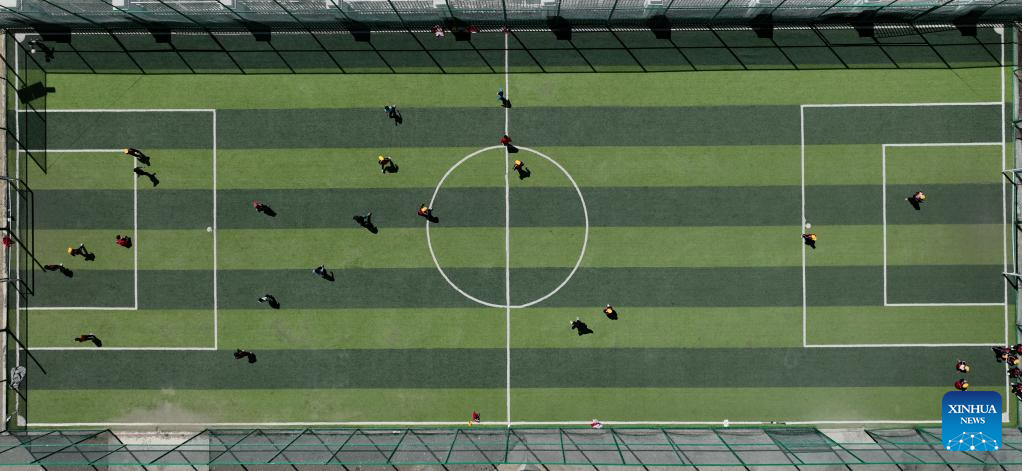
This aerial photo taken on June 5, 2023 shows pupils playing soccer at a primary school of Zhaxizom Township in Tingri County, Xigaze City, southwest China's Tibet Autonomous Region.
The primary school of Zhaxizom Township is the closest school to Mount Qomolangma, with a distance of just over 40 kilometers. To meet the various needs of the students, the school has established interest classes such as piano, information technology, art, broadcasting, sports, dance, and handicrafts.
Currently, the primary school has only one piano. Therefore, electronic keyboards are used as substitutes sometimes. Even so, it still leaves the piano teacher, Basang, feeling deeply moved.
As a local resident of Tingri County, Basang came to the school three years ago after graduating from a normal university where she learned to play the piano. "When I was in primary school, we didn't have a piano, let alone piano lessons," Basang said, "What a complete change!"
The primary school was established in 1983 and underwent a renovation and expansion project with a national investment of 8 million yuan (about 1.12 million U.S. dollars) in 2010. In 2016, the government invested over 40 million yuan (about 5.6 million U.S. dollars) for further expansion, resulting in the current scale of the school.
Today, the school has 20 classes across 6 grades, with a total of 921 students. It is equipped with modern teaching facilities, and through the national smart education platform for primary and secondary schools, students here are able to enjoy teaching resources of first-tier cities. Specialized science laboratories, calligraphy classrooms, computer rooms, libraries, and art rooms are all well-equipped. Additionally, there is an artificial turf football field and an indoor gym.
In addtion to the comprehensive facilities, children of farmers, herders and urban families facing difficulties are also exempted from meal, lodging and basic school expenses thanks to the free education policy implemented by the government in 1985.
As of 2021, the policy has benefited nearly 9 million students in Tibet, with the government investing over 20 billion yuan (about 2.8 billion U.S. dollars) in total. Currently, Tibet has also expanded this policy to preschool education. (Xinhua/Jigme Dorje)

Pupils attend a piano class at a primary school of Zhaxizom Township in Tingri County, Xigaze City, southwest China's Tibet Autonomous Region, June 5, 2023.
The primary school of Zhaxizom Township is the closest school to Mount Qomolangma, with a distance of just over 40 kilometers. To meet the various needs of the students, the school has established interest classes such as piano, information technology, art, broadcasting, sports, dance, and handicrafts.
Currently, the primary school has only one piano. Therefore, electronic keyboards are used as substitutes sometimes. Even so, it still leaves the piano teacher, Basang, feeling deeply moved.
As a local resident of Tingri County, Basang came to the school three years ago after graduating from a normal university where she learned to play the piano. "When I was in primary school, we didn't have a piano, let alone piano lessons," Basang said, "What a complete change!"
The primary school was established in 1983 and underwent a renovation and expansion project with a national investment of 8 million yuan (about 1.12 million U.S. dollars) in 2010. In 2016, the government invested over 40 million yuan (about 5.6 million U.S. dollars) for further expansion, resulting in the current scale of the school.
Today, the school has 20 classes across 6 grades, with a total of 921 students. It is equipped with modern teaching facilities, and through the national smart education platform for primary and secondary schools, students here are able to enjoy teaching resources of first-tier cities. Specialized science laboratories, calligraphy classrooms, computer rooms, libraries, and art rooms are all well-equipped. Additionally, there is an artificial turf football field and an indoor gym.
In addtion to the comprehensive facilities, children of farmers, herders and urban families facing difficulties are also exempted from meal, lodging and basic school expenses thanks to the free education policy implemented by the government in 1985.
As of 2021, the policy has benefited nearly 9 million students in Tibet, with the government investing over 20 billion yuan (about 2.8 billion U.S. dollars) in total. Currently, Tibet has also expanded this policy to preschool education. (Xinhua/Fei Maohua)
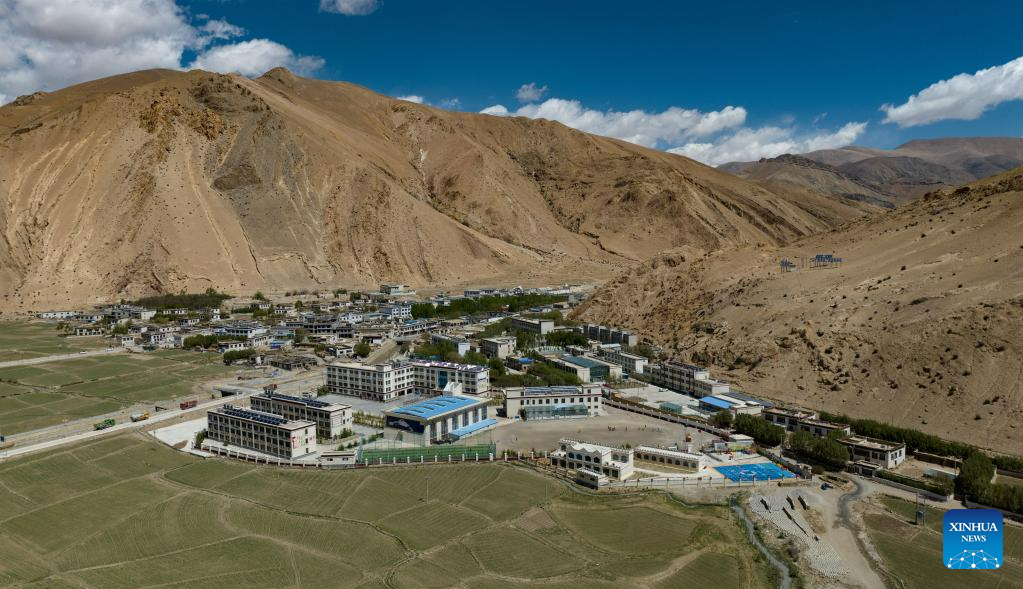
This aerial photo taken on June 5, 2023 shows a primary school of Zhaxizom Township in Tingri County, Xigaze City, southwest China's Tibet Autonomous Region.
The primary school of Zhaxizom Township is the closest school to Mount Qomolangma, with a distance of just over 40 kilometers. To meet the various needs of the students, the school has established interest classes such as piano, information technology, art, broadcasting, sports, dance, and handicrafts.
Currently, the primary school has only one piano. Therefore, electronic keyboards are used as substitutes sometimes. Even so, it still leaves the piano teacher, Basang, feeling deeply moved.
As a local resident of Tingri County, Basang came to the school three years ago after graduating from a normal university where she learned to play the piano. "When I was in primary school, we didn't have a piano, let alone piano lessons," Basang said, "What a complete change!"
The primary school was established in 1983 and underwent a renovation and expansion project with a national investment of 8 million yuan (about 1.12 million U.S. dollars) in 2010. In 2016, the government invested over 40 million yuan (about 5.6 million U.S. dollars) for further expansion, resulting in the current scale of the school.
Today, the school has 20 classes across 6 grades, with a total of 921 students. It is equipped with modern teaching facilities, and through the national smart education platform for primary and secondary schools, students here are able to enjoy teaching resources of first-tier cities. Specialized science laboratories, calligraphy classrooms, computer rooms, libraries, and art rooms are all well-equipped. Additionally, there is an artificial turf football field and an indoor gym.
In addtion to the comprehensive facilities, children of farmers, herders and urban families facing difficulties are also exempted from meal, lodging and basic school expenses thanks to the free education policy implemented by the government in 1985.
As of 2021, the policy has benefited nearly 9 million students in Tibet, with the government investing over 20 billion yuan (about 2.8 billion U.S. dollars) in total. Currently, Tibet has also expanded this policy to preschool education. (Xinhua/Jigme Dorje)
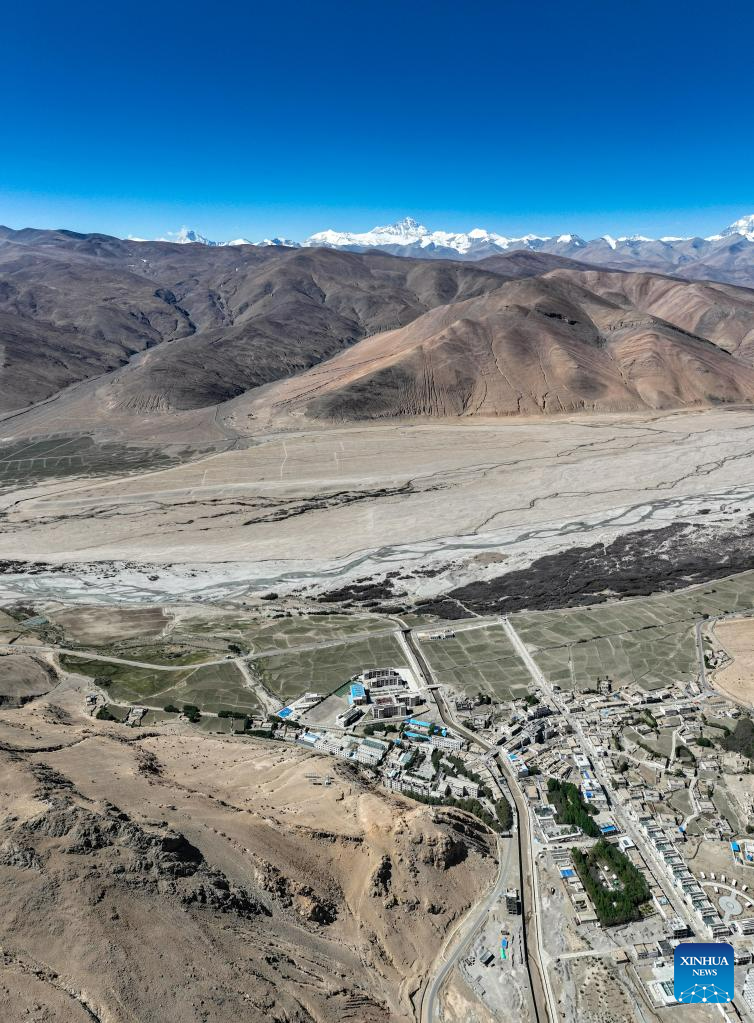
This aerial photo taken on June 5, 2023 shows a primary school of Zhaxizom Township in Tingri County, Xigaze City, southwest China's Tibet Autonomous Region.
The primary school of Zhaxizom Township is the closest school to Mount Qomolangma, with a distance of just over 40 kilometers. To meet the various needs of the students, the school has established interest classes such as piano, information technology, art, broadcasting, sports, dance, and handicrafts.
Currently, the primary school has only one piano. Therefore, electronic keyboards are used as substitutes sometimes. Even so, it still leaves the piano teacher, Basang, feeling deeply moved.
As a local resident of Tingri County, Basang came to the school three years ago after graduating from a normal university where she learned to play the piano. "When I was in primary school, we didn't have a piano, let alone piano lessons," Basang said, "What a complete change!"
The primary school was established in 1983 and underwent a renovation and expansion project with a national investment of 8 million yuan (about 1.12 million U.S. dollars) in 2010. In 2016, the government invested over 40 million yuan (about 5.6 million U.S. dollars) for further expansion, resulting in the current scale of the school.
Today, the school has 20 classes across 6 grades, with a total of 921 students. It is equipped with modern teaching facilities, and through the national smart education platform for primary and secondary schools, students here are able to enjoy teaching resources of first-tier cities. Specialized science laboratories, calligraphy classrooms, computer rooms, libraries, and art rooms are all well-equipped. Additionally, there is an artificial turf football field and an indoor gym.
In addtion to the comprehensive facilities, children of farmers, herders and urban families facing difficulties are also exempted from meal, lodging and basic school expenses thanks to the free education policy implemented by the government in 1985.
As of 2021, the policy has benefited nearly 9 million students in Tibet, with the government investing over 20 billion yuan (about 2.8 billion U.S. dollars) in total. Currently, Tibet has also expanded this policy to preschool education. (Xinhua/Jigme Dorje)

Pupils attend a science class at a primary school of Zhaxizom Township in Tingri County, Xigaze City, southwest China's Tibet Autonomous Region, June 5, 2023.
The primary school of Zhaxizom Township is the closest school to Mount Qomolangma, with a distance of just over 40 kilometers. To meet the various needs of the students, the school has established interest classes such as piano, information technology, art, broadcasting, sports, dance, and handicrafts.
Currently, the primary school has only one piano. Therefore, electronic keyboards are used as substitutes sometimes. Even so, it still leaves the piano teacher, Basang, feeling deeply moved.
As a local resident of Tingri County, Basang came to the school three years ago after graduating from a normal university where she learned to play the piano. "When I was in primary school, we didn't have a piano, let alone piano lessons," Basang said, "What a complete change!"
The primary school was established in 1983 and underwent a renovation and expansion project with a national investment of 8 million yuan (about 1.12 million U.S. dollars) in 2010. In 2016, the government invested over 40 million yuan (about 5.6 million U.S. dollars) for further expansion, resulting in the current scale of the school.
Today, the school has 20 classes across 6 grades, with a total of 921 students. It is equipped with modern teaching facilities, and through the national smart education platform for primary and secondary schools, students here are able to enjoy teaching resources of first-tier cities. Specialized science laboratories, calligraphy classrooms, computer rooms, libraries, and art rooms are all well-equipped. Additionally, there is an artificial turf football field and an indoor gym.
In addtion to the comprehensive facilities, children of farmers, herders and urban families facing difficulties are also exempted from meal, lodging and basic school expenses thanks to the free education policy implemented by the government in 1985.
As of 2021, the policy has benefited nearly 9 million students in Tibet, with the government investing over 20 billion yuan (about 2.8 billion U.S. dollars) in total. Currently, Tibet has also expanded this policy to preschool education. (Xinhua/Jigme Dorje)
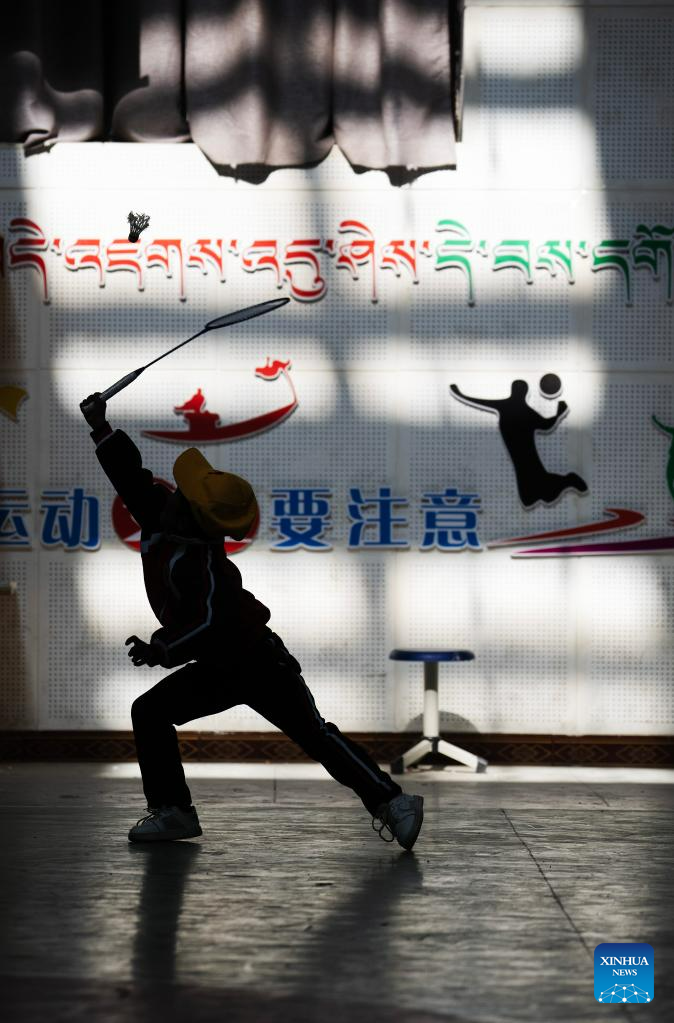
A pupil attends a sports class at the indoor gym at a primary school of Zhaxizom Township in Tingri County, Xigaze City, southwest China's Tibet Autonomous Region, June 5, 2023.
The primary school of Zhaxizom Township is the closest school to Mount Qomolangma, with a distance of just over 40 kilometers. To meet the various needs of the students, the school has established interest classes such as piano, information technology, art, broadcasting, sports, dance, and handicrafts.
Currently, the primary school has only one piano. Therefore, electronic keyboards are used as substitutes sometimes. Even so, it still leaves the piano teacher, Basang, feeling deeply moved.
As a local resident of Tingri County, Basang came to the school three years ago after graduating from a normal university where she learned to play the piano. "When I was in primary school, we didn't have a piano, let alone piano lessons," Basang said, "What a complete change!"
The primary school was established in 1983 and underwent a renovation and expansion project with a national investment of 8 million yuan (about 1.12 million U.S. dollars) in 2010. In 2016, the government invested over 40 million yuan (about 5.6 million U.S. dollars) for further expansion, resulting in the current scale of the school.
Today, the school has 20 classes across 6 grades, with a total of 921 students. It is equipped with modern teaching facilities, and through the national smart education platform for primary and secondary schools, students here are able to enjoy teaching resources of first-tier cities. Specialized science laboratories, calligraphy classrooms, computer rooms, libraries, and art rooms are all well-equipped. Additionally, there is an artificial turf football field and an indoor gym.
In addtion to the comprehensive facilities, children of farmers, herders and urban families facing difficulties are also exempted from meal, lodging and basic school expenses thanks to the free education policy implemented by the government in 1985.
As of 2021, the policy has benefited nearly 9 million students in Tibet, with the government investing over 20 billion yuan (about 2.8 billion U.S. dollars) in total. Currently, Tibet has also expanded this policy to preschool education. (Xinhua/Fei Maohua)
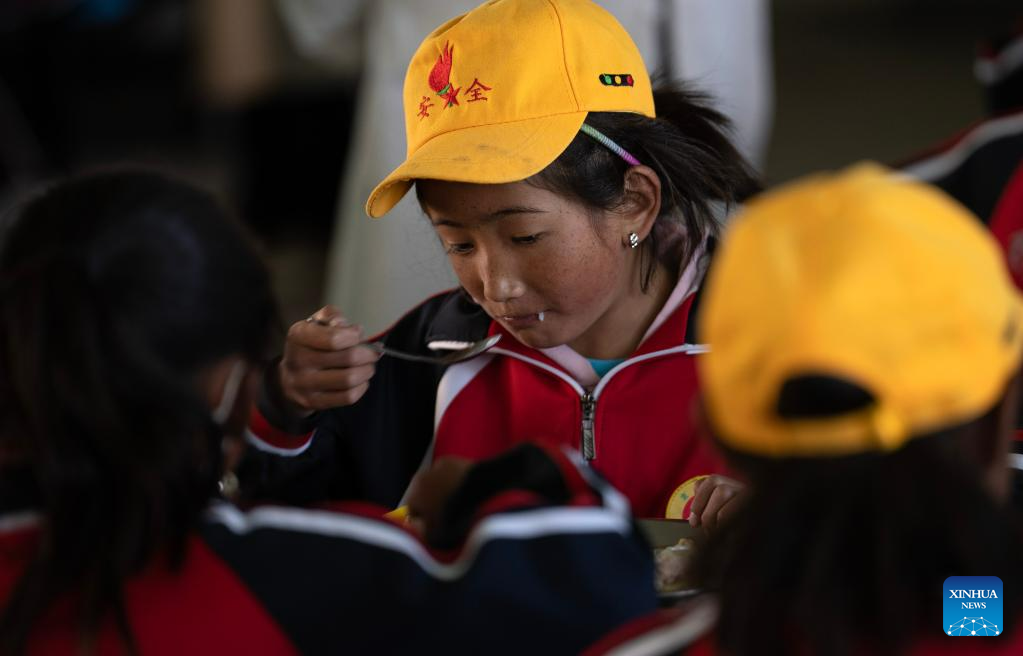
Pupils have lunch at the canteen of a primary school of Zhaxizom Township in Tingri County, Xigaze City, southwest China's Tibet Autonomous Region, June 5, 2023.
The primary school of Zhaxizom Township is the closest school to Mount Qomolangma, with a distance of just over 40 kilometers. To meet the various needs of the students, the school has established interest classes such as piano, information technology, art, broadcasting, sports, dance, and handicrafts.
Currently, the primary school has only one piano. Therefore, electronic keyboards are used as substitutes sometimes. Even so, it still leaves the piano teacher, Basang, feeling deeply moved.
As a local resident of Tingri County, Basang came to the school three years ago after graduating from a normal university where she learned to play the piano. "When I was in primary school, we didn't have a piano, let alone piano lessons," Basang said, "What a complete change!"
The primary school was established in 1983 and underwent a renovation and expansion project with a national investment of 8 million yuan (about 1.12 million U.S. dollars) in 2010. In 2016, the government invested over 40 million yuan (about 5.6 million U.S. dollars) for further expansion, resulting in the current scale of the school.
Today, the school has 20 classes across 6 grades, with a total of 921 students. It is equipped with modern teaching facilities, and through the national smart education platform for primary and secondary schools, students here are able to enjoy teaching resources of first-tier cities. Specialized science laboratories, calligraphy classrooms, computer rooms, libraries, and art rooms are all well-equipped. Additionally, there is an artificial turf football field and an indoor gym.
In addtion to the comprehensive facilities, children of farmers, herders and urban families facing difficulties are also exempted from meal, lodging and basic school expenses thanks to the free education policy implemented by the government in 1985.
As of 2021, the policy has benefited nearly 9 million students in Tibet, with the government investing over 20 billion yuan (about 2.8 billion U.S. dollars) in total. Currently, Tibet has also expanded this policy to preschool education. (Xinhua/Fei Maohua)
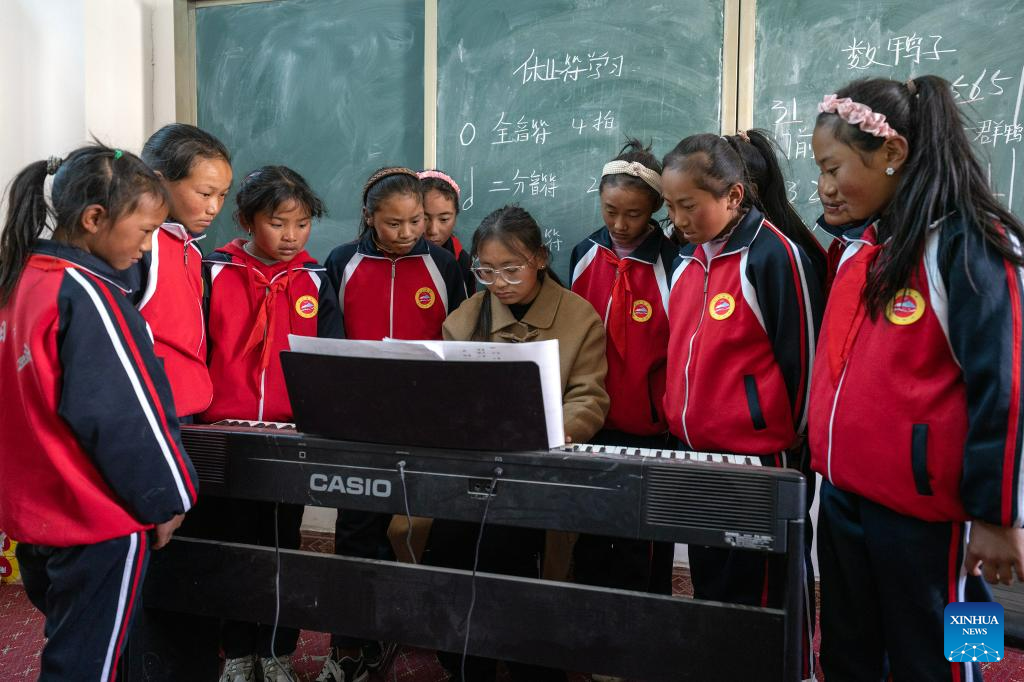
Piano teacher Basang (C) instructs students at a primary school of Zhaxizom Township in Tingri County, Xigaze City, southwest China's Tibet Autonomous Region, June 5, 2023.
The primary school of Zhaxizom Township is the closest school to Mount Qomolangma, with a distance of just over 40 kilometers. To meet the various needs of the students, the school has established interest classes such as piano, information technology, art, broadcasting, sports, dance, and handicrafts.
Currently, the primary school has only one piano. Therefore, electronic keyboards are used as substitutes sometimes. Even so, it still leaves the piano teacher, Basang, feeling deeply moved.
As a local resident of Tingri County, Basang came to the school three years ago after graduating from a normal university where she learned to play the piano. "When I was in primary school, we didn't have a piano, let alone piano lessons," Basang said, "What a complete change!"
The primary school was established in 1983 and underwent a renovation and expansion project with a national investment of 8 million yuan (about 1.12 million U.S. dollars) in 2010. In 2016, the government invested over 40 million yuan (about 5.6 million U.S. dollars) for further expansion, resulting in the current scale of the school.
Today, the school has 20 classes across 6 grades, with a total of 921 students. It is equipped with modern teaching facilities, and through the national smart education platform for primary and secondary schools, students here are able to enjoy teaching resources of first-tier cities. Specialized science laboratories, calligraphy classrooms, computer rooms, libraries, and art rooms are all well-equipped. Additionally, there is an artificial turf football field and an indoor gym.
In addtion to the comprehensive facilities, children of farmers, herders and urban families facing difficulties are also exempted from meal, lodging and basic school expenses thanks to the free education policy implemented by the government in 1985.
As of 2021, the policy has benefited nearly 9 million students in Tibet, with the government investing over 20 billion yuan (about 2.8 billion U.S. dollars) in total. Currently, Tibet has also expanded this policy to preschool education. (Xinhua/Fei Maohua)
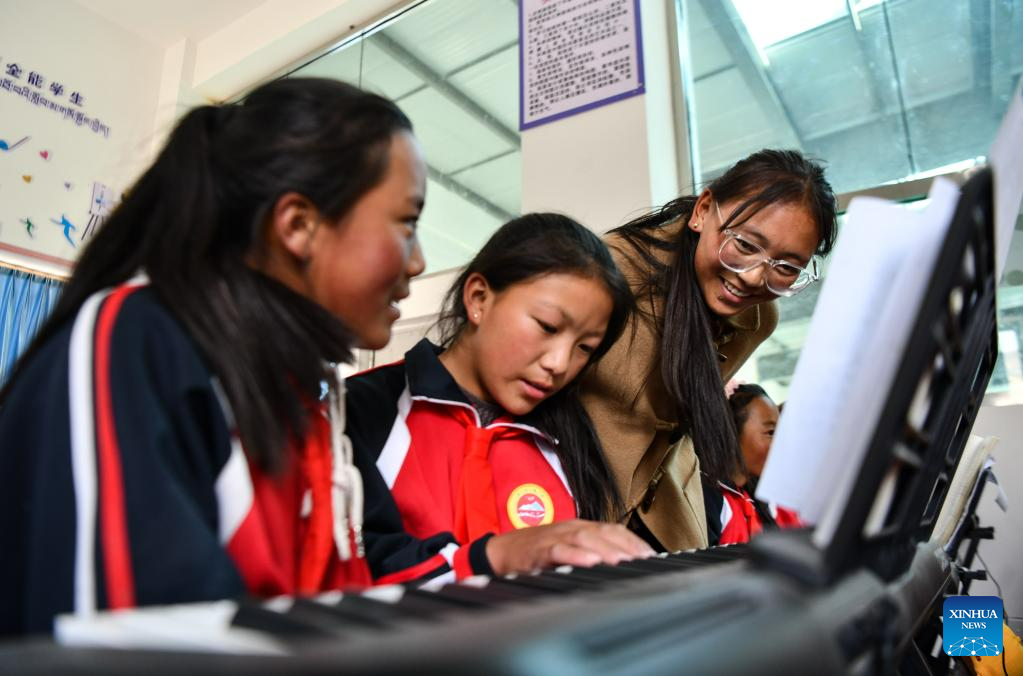
Piano teacher Basang (R) instructs students at a primary school of Zhaxizom Township in Tingri County, Xigaze City, southwest China's Tibet Autonomous Region, June 5, 2023.
The primary school of Zhaxizom Township is the closest school to Mount Qomolangma, with a distance of just over 40 kilometers. To meet the various needs of the students, the school has established interest classes such as piano, information technology, art, broadcasting, sports, dance, and handicrafts.
Currently, the primary school has only one piano. Therefore, electronic keyboards are used as substitutes sometimes. Even so, it still leaves the piano teacher, Basang, feeling deeply moved.
As a local resident of Tingri County, Basang came to the school three years ago after graduating from a normal university where she learned to play the piano. "When I was in primary school, we didn't have a piano, let alone piano lessons," Basang said, "What a complete change!"
The primary school was established in 1983 and underwent a renovation and expansion project with a national investment of 8 million yuan (about 1.12 million U.S. dollars) in 2010. In 2016, the government invested over 40 million yuan (about 5.6 million U.S. dollars) for further expansion, resulting in the current scale of the school.
Today, the school has 20 classes across 6 grades, with a total of 921 students. It is equipped with modern teaching facilities, and through the national smart education platform for primary and secondary schools, students here are able to enjoy teaching resources of first-tier cities. Specialized science laboratories, calligraphy classrooms, computer rooms, libraries, and art rooms are all well-equipped. Additionally, there is an artificial turf football field and an indoor gym.
In addtion to the comprehensive facilities, children of farmers, herders and urban families facing difficulties are also exempted from meal, lodging and basic school expenses thanks to the free education policy implemented by the government in 1985.
As of 2021, the policy has benefited nearly 9 million students in Tibet, with the government investing over 20 billion yuan (about 2.8 billion U.S. dollars) in total. Currently, Tibet has also expanded this policy to preschool education. (Xinhua/Jigme Dorje)

Pupils have lunch at the canteen of a primary school of Zhaxizom Township in Tingri County, Xigaze City, southwest China's Tibet Autonomous Region, June 5, 2023.
The primary school of Zhaxizom Township is the closest school to Mount Qomolangma, with a distance of just over 40 kilometers. To meet the various needs of the students, the school has established interest classes such as piano, information technology, art, broadcasting, sports, dance, and handicrafts.
Currently, the primary school has only one piano. Therefore, electronic keyboards are used as substitutes sometimes. Even so, it still leaves the piano teacher, Basang, feeling deeply moved.
As a local resident of Tingri County, Basang came to the school three years ago after graduating from a normal university where she learned to play the piano. "When I was in primary school, we didn't have a piano, let alone piano lessons," Basang said, "What a complete change!"
The primary school was established in 1983 and underwent a renovation and expansion project with a national investment of 8 million yuan (about 1.12 million U.S. dollars) in 2010. In 2016, the government invested over 40 million yuan (about 5.6 million U.S. dollars) for further expansion, resulting in the current scale of the school.
Today, the school has 20 classes across 6 grades, with a total of 921 students. It is equipped with modern teaching facilities, and through the national smart education platform for primary and secondary schools, students here are able to enjoy teaching resources of first-tier cities. Specialized science laboratories, calligraphy classrooms, computer rooms, libraries, and art rooms are all well-equipped. Additionally, there is an artificial turf football field and an indoor gym.
In addtion to the comprehensive facilities, children of farmers, herders and urban families facing difficulties are also exempted from meal, lodging and basic school expenses thanks to the free education policy implemented by the government in 1985.
As of 2021, the policy has benefited nearly 9 million students in Tibet, with the government investing over 20 billion yuan (about 2.8 billion U.S. dollars) in total. Currently, Tibet has also expanded this policy to preschool education. (Xinhua/Jigme Dorje)
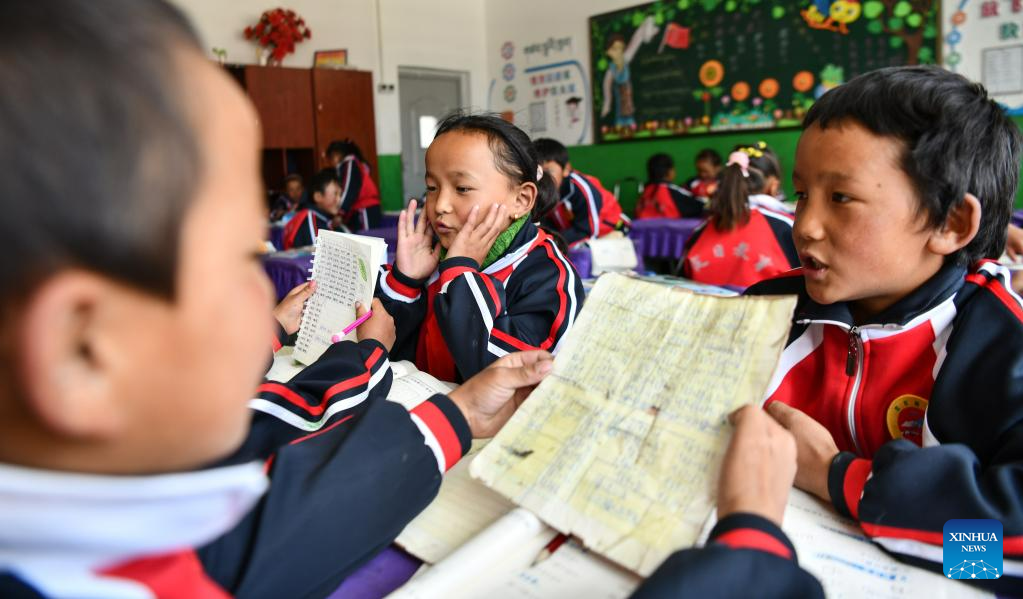
Pupils study at a primary school of Zhaxizom Township in Tingri County, Xigaze City, southwest China's Tibet Autonomous Region, June 5, 2023.
The primary school of Zhaxizom Township is the closest school to Mount Qomolangma, with a distance of just over 40 kilometers. To meet the various needs of the students, the school has established interest classes such as piano, information technology, art, broadcasting, sports, dance, and handicrafts.
Currently, the primary school has only one piano. Therefore, electronic keyboards are used as substitutes sometimes. Even so, it still leaves the piano teacher, Basang, feeling deeply moved.
As a local resident of Tingri County, Basang came to the school three years ago after graduating from a normal university where she learned to play the piano. "When I was in primary school, we didn't have a piano, let alone piano lessons," Basang said, "What a complete change!"
The primary school was established in 1983 and underwent a renovation and expansion project with a national investment of 8 million yuan (about 1.12 million U.S. dollars) in 2010. In 2016, the government invested over 40 million yuan (about 5.6 million U.S. dollars) for further expansion, resulting in the current scale of the school.
Today, the school has 20 classes across 6 grades, with a total of 921 students. It is equipped with modern teaching facilities, and through the national smart education platform for primary and secondary schools, students here are able to enjoy teaching resources of first-tier cities. Specialized science laboratories, calligraphy classrooms, computer rooms, libraries, and art rooms are all well-equipped. Additionally, there is an artificial turf football field and an indoor gym.
In addtion to the comprehensive facilities, children of farmers, herders and urban families facing difficulties are also exempted from meal, lodging and basic school expenses thanks to the free education policy implemented by the government in 1985.
As of 2021, the policy has benefited nearly 9 million students in Tibet, with the government investing over 20 billion yuan (about 2.8 billion U.S. dollars) in total. Currently, Tibet has also expanded this policy to preschool education. (Xinhua/Jigme Dorje)
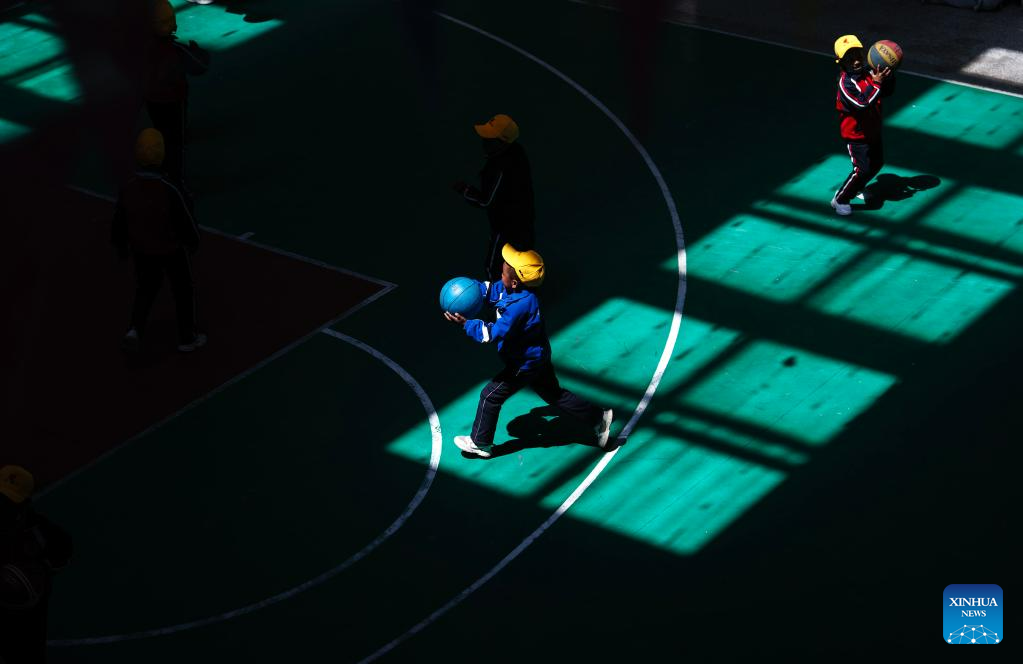
Pupils attend a basketball class at the indoor gym at a primary school of Zhaxizom Township in Tingri County, Xigaze City, southwest China's Tibet Autonomous Region, June 5, 2023.
The primary school of Zhaxizom Township is the closest school to Mount Qomolangma, with a distance of just over 40 kilometers. To meet the various needs of the students, the school has established interest classes such as piano, information technology, art, broadcasting, sports, dance, and handicrafts.
Currently, the primary school has only one piano. Therefore, electronic keyboards are used as substitutes sometimes. Even so, it still leaves the piano teacher, Basang, feeling deeply moved.
As a local resident of Tingri County, Basang came to the school three years ago after graduating from a normal university where she learned to play the piano. "When I was in primary school, we didn't have a piano, let alone piano lessons," Basang said, "What a complete change!"
The primary school was established in 1983 and underwent a renovation and expansion project with a national investment of 8 million yuan (about 1.12 million U.S. dollars) in 2010. In 2016, the government invested over 40 million yuan (about 5.6 million U.S. dollars) for further expansion, resulting in the current scale of the school.
Today, the school has 20 classes across 6 grades, with a total of 921 students. It is equipped with modern teaching facilities, and through the national smart education platform for primary and secondary schools, students here are able to enjoy teaching resources of first-tier cities. Specialized science laboratories, calligraphy classrooms, computer rooms, libraries, and art rooms are all well-equipped. Additionally, there is an artificial turf football field and an indoor gym.
In addtion to the comprehensive facilities, children of farmers, herders and urban families facing difficulties are also exempted from meal, lodging and basic school expenses thanks to the free education policy implemented by the government in 1985.
As of 2021, the policy has benefited nearly 9 million students in Tibet, with the government investing over 20 billion yuan (about 2.8 billion U.S. dollars) in total. Currently, Tibet has also expanded this policy to preschool education. (Xinhua/Fei Maohua)
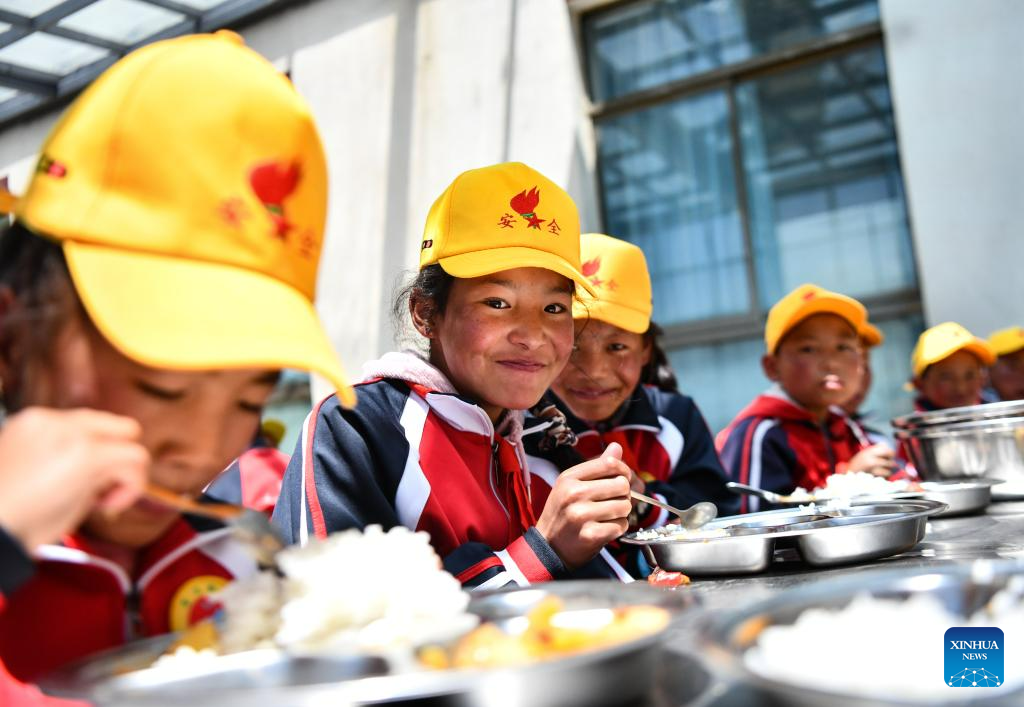
Pupils have lunch at a primary school of Zhaxizom Township in Tingri County, Xigaze City, southwest China's Tibet Autonomous Region, June 5, 2023.
The primary school of Zhaxizom Township is the closest school to Mount Qomolangma, with a distance of just over 40 kilometers. To meet the various needs of the students, the school has established interest classes such as piano, information technology, art, broadcasting, sports, dance, and handicrafts.
Currently, the primary school has only one piano. Therefore, electronic keyboards are used as substitutes sometimes. Even so, it still leaves the piano teacher, Basang, feeling deeply moved.
As a local resident of Tingri County, Basang came to the school three years ago after graduating from a normal university where she learned to play the piano. "When I was in primary school, we didn't have a piano, let alone piano lessons," Basang said, "What a complete change!"
The primary school was established in 1983 and underwent a renovation and expansion project with a national investment of 8 million yuan (about 1.12 million U.S. dollars) in 2010. In 2016, the government invested over 40 million yuan (about 5.6 million U.S. dollars) for further expansion, resulting in the current scale of the school.
Today, the school has 20 classes across 6 grades, with a total of 921 students. It is equipped with modern teaching facilities, and through the national smart education platform for primary and secondary schools, students here are able to enjoy teaching resources of first-tier cities. Specialized science laboratories, calligraphy classrooms, computer rooms, libraries, and art rooms are all well-equipped. Additionally, there is an artificial turf football field and an indoor gym.
In addtion to the comprehensive facilities, children of farmers, herders and urban families facing difficulties are also exempted from meal, lodging and basic school expenses thanks to the free education policy implemented by the government in 1985.
As of 2021, the policy has benefited nearly 9 million students in Tibet, with the government investing over 20 billion yuan (about 2.8 billion U.S. dollars) in total. Currently, Tibet has also expanded this policy to preschool education. (Xinhua/Jigme Dorje)

Pupils attend a computer class at a primary school of Zhaxizom Township in Tingri County, Xigaze City, southwest China's Tibet Autonomous Region, June 5, 2023.
The primary school of Zhaxizom Township is the closest school to Mount Qomolangma, with a distance of just over 40 kilometers. To meet the various needs of the students, the school has established interest classes such as piano, information technology, art, broadcasting, sports, dance, and handicrafts.
Currently, the primary school has only one piano. Therefore, electronic keyboards are used as substitutes sometimes. Even so, it still leaves the piano teacher, Basang, feeling deeply moved.
As a local resident of Tingri County, Basang came to the school three years ago after graduating from a normal university where she learned to play the piano. "When I was in primary school, we didn't have a piano, let alone piano lessons," Basang said, "What a complete change!"
The primary school was established in 1983 and underwent a renovation and expansion project with a national investment of 8 million yuan (about 1.12 million U.S. dollars) in 2010. In 2016, the government invested over 40 million yuan (about 5.6 million U.S. dollars) for further expansion, resulting in the current scale of the school.
Today, the school has 20 classes across 6 grades, with a total of 921 students. It is equipped with modern teaching facilities, and through the national smart education platform for primary and secondary schools, students here are able to enjoy teaching resources of first-tier cities. Specialized science laboratories, calligraphy classrooms, computer rooms, libraries, and art rooms are all well-equipped. Additionally, there is an artificial turf football field and an indoor gym.
In addtion to the comprehensive facilities, children of farmers, herders and urban families facing difficulties are also exempted from meal, lodging and basic school expenses thanks to the free education policy implemented by the government in 1985.
As of 2021, the policy has benefited nearly 9 million students in Tibet, with the government investing over 20 billion yuan (about 2.8 billion U.S. dollars) in total. Currently, Tibet has also expanded this policy to preschool education. (Xinhua/Fei Maohua)
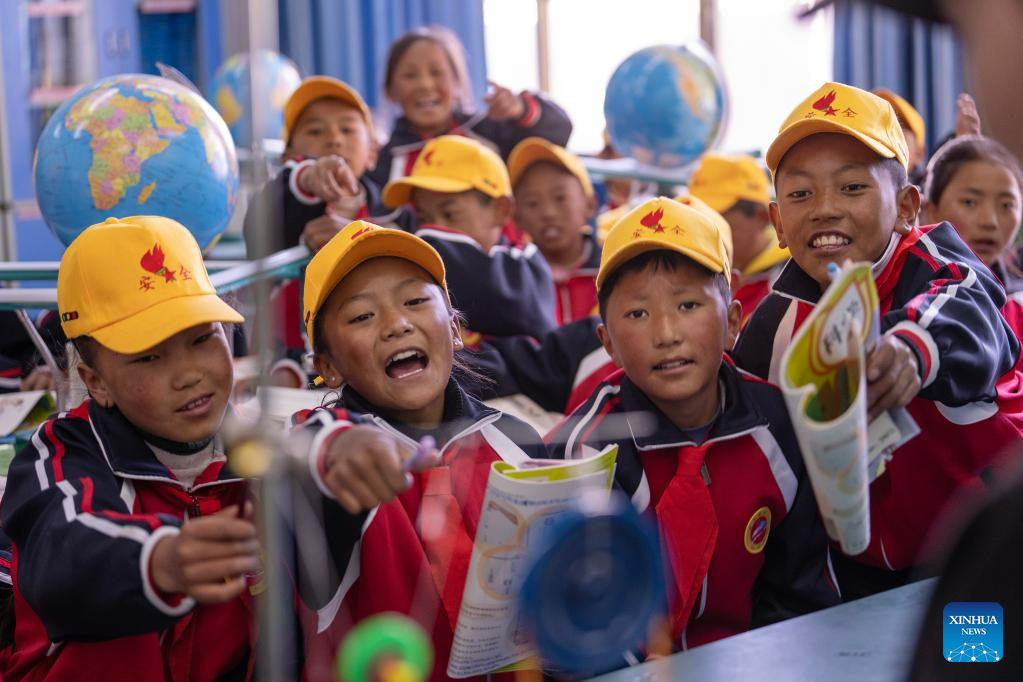
Pupils attend a science class at a primary school of Zhaxizom Township in Tingri County, Xigaze City, southwest China's Tibet Autonomous Region, June 5, 2023.
The primary school of Zhaxizom Township is the closest school to Mount Qomolangma, with a distance of just over 40 kilometers. To meet the various needs of the students, the school has established interest classes such as piano, information technology, art, broadcasting, sports, dance, and handicrafts.
Currently, the primary school has only one piano. Therefore, electronic keyboards are used as substitutes sometimes. Even so, it still leaves the piano teacher, Basang, feeling deeply moved.
As a local resident of Tingri County, Basang came to the school three years ago after graduating from a normal university where she learned to play the piano. "When I was in primary school, we didn't have a piano, let alone piano lessons," Basang said, "What a complete change!"
The primary school was established in 1983 and underwent a renovation and expansion project with a national investment of 8 million yuan (about 1.12 million U.S. dollars) in 2010. In 2016, the government invested over 40 million yuan (about 5.6 million U.S. dollars) for further expansion, resulting in the current scale of the school.
Today, the school has 20 classes across 6 grades, with a total of 921 students. It is equipped with modern teaching facilities, and through the national smart education platform for primary and secondary schools, students here are able to enjoy teaching resources of first-tier cities. Specialized science laboratories, calligraphy classrooms, computer rooms, libraries, and art rooms are all well-equipped. Additionally, there is an artificial turf football field and an indoor gym.
In addtion to the comprehensive facilities, children of farmers, herders and urban families facing difficulties are also exempted from meal, lodging and basic school expenses thanks to the free education policy implemented by the government in 1985.
As of 2021, the policy has benefited nearly 9 million students in Tibet, with the government investing over 20 billion yuan (about 2.8 billion U.S. dollars) in total. Currently, Tibet has also expanded this policy to preschool education. (Xinhua/Fei Maohua)
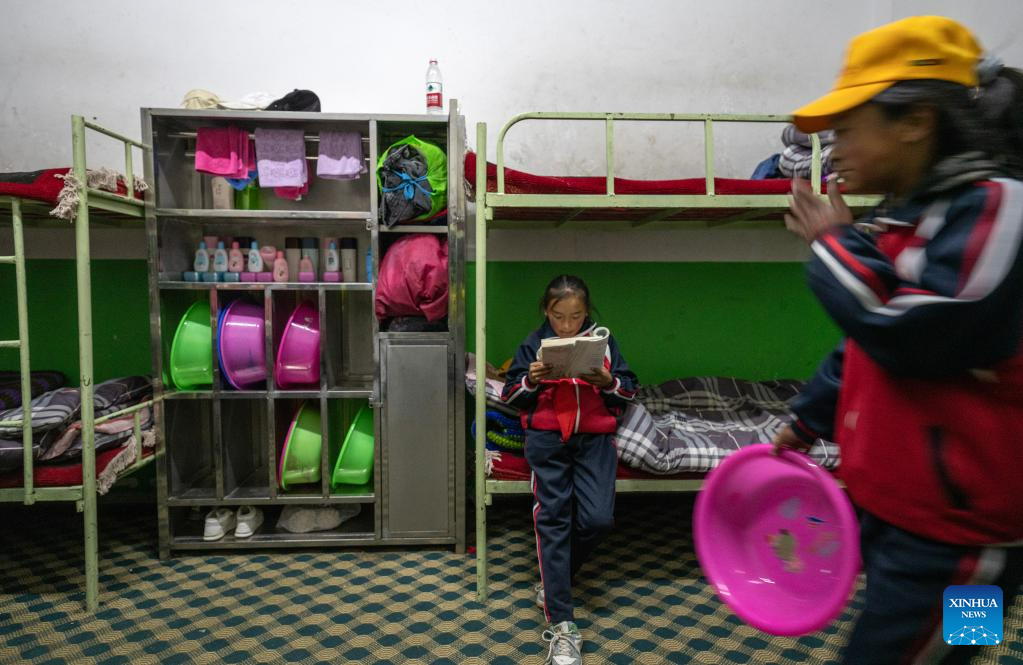
A pupil reads at the dormitory at a primary school of Zhaxizom Township in Tingri County, Xigaze City, southwest China's Tibet Autonomous Region, June 5, 2023.
The primary school of Zhaxizom Township is the closest school to Mount Qomolangma, with a distance of just over 40 kilometers. To meet the various needs of the students, the school has established interest classes such as piano, information technology, art, broadcasting, sports, dance, and handicrafts.
Currently, the primary school has only one piano. Therefore, electronic keyboards are used as substitutes sometimes. Even so, it still leaves the piano teacher, Basang, feeling deeply moved.
As a local resident of Tingri County, Basang came to the school three years ago after graduating from a normal university where she learned to play the piano. "When I was in primary school, we didn't have a piano, let alone piano lessons," Basang said, "What a complete change!"
The primary school was established in 1983 and underwent a renovation and expansion project with a national investment of 8 million yuan (about 1.12 million U.S. dollars) in 2010. In 2016, the government invested over 40 million yuan (about 5.6 million U.S. dollars) for further expansion, resulting in the current scale of the school.
Today, the school has 20 classes across 6 grades, with a total of 921 students. It is equipped with modern teaching facilities, and through the national smart education platform for primary and secondary schools, students here are able to enjoy teaching resources of first-tier cities. Specialized science laboratories, calligraphy classrooms, computer rooms, libraries, and art rooms are all well-equipped. Additionally, there is an artificial turf football field and an indoor gym.
In addtion to the comprehensive facilities, children of farmers, herders and urban families facing difficulties are also exempted from meal, lodging and basic school expenses thanks to the free education policy implemented by the government in 1985.
As of 2021, the policy has benefited nearly 9 million students in Tibet, with the government investing over 20 billion yuan (about 2.8 billion U.S. dollars) in total. Currently, Tibet has also expanded this policy to preschool education. (Xinhua/Fei Maohua)

Danba Rinqen, vice president of a primary school of Zhaxizom Township, instructs students in a science class in Tingri County, Xigaze City, southwest China's Tibet Autonomous Region, June 5, 2023.
The primary school of Zhaxizom Township is the closest school to Mount Qomolangma, with a distance of just over 40 kilometers. To meet the various needs of the students, the school has established interest classes such as piano, information technology, art, broadcasting, sports, dance, and handicrafts.
Currently, the primary school has only one piano. Therefore, electronic keyboards are used as substitutes sometimes. Even so, it still leaves the piano teacher, Basang, feeling deeply moved.
As a local resident of Tingri County, Basang came to the school three years ago after graduating from a normal university where she learned to play the piano. "When I was in primary school, we didn't have a piano, let alone piano lessons," Basang said, "What a complete change!"
The primary school was established in 1983 and underwent a renovation and expansion project with a national investment of 8 million yuan (about 1.12 million U.S. dollars) in 2010. In 2016, the government invested over 40 million yuan (about 5.6 million U.S. dollars) for further expansion, resulting in the current scale of the school.
Today, the school has 20 classes across 6 grades, with a total of 921 students. It is equipped with modern teaching facilities, and through the national smart education platform for primary and secondary schools, students here are able to enjoy teaching resources of first-tier cities. Specialized science laboratories, calligraphy classrooms, computer rooms, libraries, and art rooms are all well-equipped. Additionally, there is an artificial turf football field and an indoor gym.
In addtion to the comprehensive facilities, children of farmers, herders and urban families facing difficulties are also exempted from meal, lodging and basic school expenses thanks to the free education policy implemented by the government in 1985.
As of 2021, the policy has benefited nearly 9 million students in Tibet, with the government investing over 20 billion yuan (about 2.8 billion U.S. dollars) in total. Currently, Tibet has also expanded this policy to preschool education. (Xinhua/Jigme Dorje)
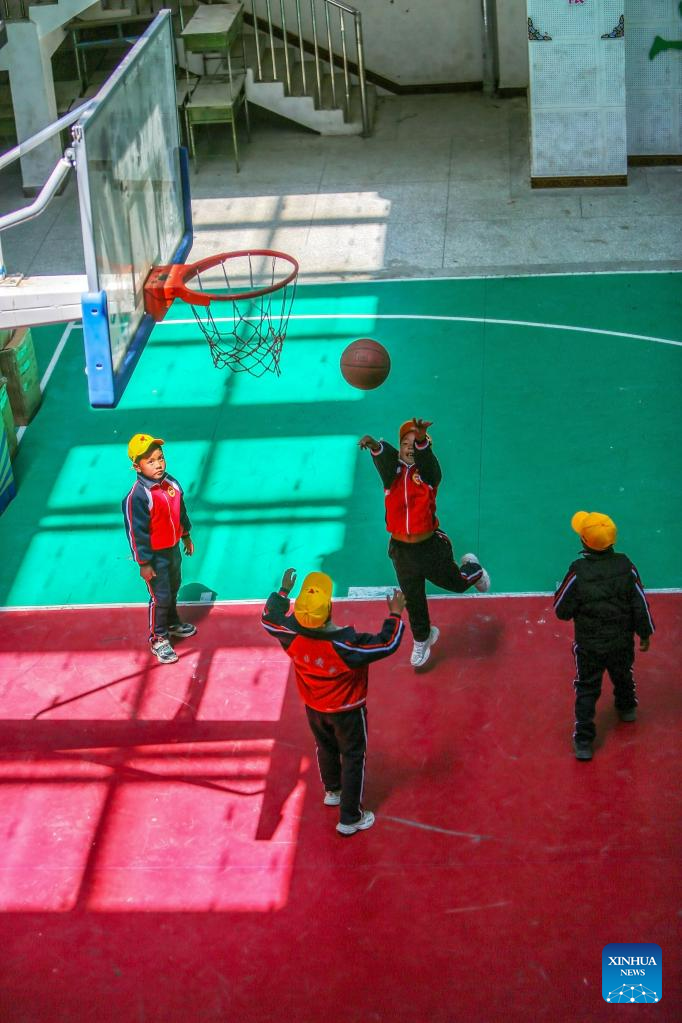
A pupil shoots during a basketball class at a primary school of Zhaxizom Township in Tingri County, Xigaze City, southwest China's Tibet Autonomous Region, June 5, 2023.
The primary school of Zhaxizom Township is the closest school to Mount Qomolangma, with a distance of just over 40 kilometers. To meet the various needs of the students, the school has established interest classes such as piano, information technology, art, broadcasting, sports, dance, and handicrafts.
Currently, the primary school has only one piano. Therefore, electronic keyboards are used as substitutes sometimes. Even so, it still leaves the piano teacher, Basang, feeling deeply moved.
As a local resident of Tingri County, Basang came to the school three years ago after graduating from a normal university where she learned to play the piano. "When I was in primary school, we didn't have a piano, let alone piano lessons," Basang said, "What a complete change!"
The primary school was established in 1983 and underwent a renovation and expansion project with a national investment of 8 million yuan (about 1.12 million U.S. dollars) in 2010. In 2016, the government invested over 40 million yuan (about 5.6 million U.S. dollars) for further expansion, resulting in the current scale of the school.
Today, the school has 20 classes across 6 grades, with a total of 921 students. It is equipped with modern teaching facilities, and through the national smart education platform for primary and secondary schools, students here are able to enjoy teaching resources of first-tier cities. Specialized science laboratories, calligraphy classrooms, computer rooms, libraries, and art rooms are all well-equipped. Additionally, there is an artificial turf football field and an indoor gym.
In addtion to the comprehensive facilities, children of farmers, herders and urban families facing difficulties are also exempted from meal, lodging and basic school expenses thanks to the free education policy implemented by the government in 1985.
As of 2021, the policy has benefited nearly 9 million students in Tibet, with the government investing over 20 billion yuan (about 2.8 billion U.S. dollars) in total. Currently, Tibet has also expanded this policy to preschool education. (Xinhua/Shao Zedong)

Pupils attend a piano class at a primary school of Zhaxizom Township in Tingri County, Xigaze City, southwest China's Tibet Autonomous Region, June 5, 2023.
The primary school of Zhaxizom Township is the closest school to Mount Qomolangma, with a distance of just over 40 kilometers. To meet the various needs of the students, the school has established interest classes such as piano, information technology, art, broadcasting, sports, dance, and handicrafts.
Currently, the primary school has only one piano. Therefore, electronic keyboards are used as substitutes sometimes. Even so, it still leaves the piano teacher, Basang, feeling deeply moved.
As a local resident of Tingri County, Basang came to the school three years ago after graduating from a normal university where she learned to play the piano. "When I was in primary school, we didn't have a piano, let alone piano lessons," Basang said, "What a complete change!"
The primary school was established in 1983 and underwent a renovation and expansion project with a national investment of 8 million yuan (about 1.12 million U.S. dollars) in 2010. In 2016, the government invested over 40 million yuan (about 5.6 million U.S. dollars) for further expansion, resulting in the current scale of the school.
Today, the school has 20 classes across 6 grades, with a total of 921 students. It is equipped with modern teaching facilities, and through the national smart education platform for primary and secondary schools, students here are able to enjoy teaching resources of first-tier cities. Specialized science laboratories, calligraphy classrooms, computer rooms, libraries, and art rooms are all well-equipped. Additionally, there is an artificial turf football field and an indoor gym.
In addtion to the comprehensive facilities, children of farmers, herders and urban families facing difficulties are also exempted from meal, lodging and basic school expenses thanks to the free education policy implemented by the government in 1985.
As of 2021, the policy has benefited nearly 9 million students in Tibet, with the government investing over 20 billion yuan (about 2.8 billion U.S. dollars) in total. Currently, Tibet has also expanded this policy to preschool education. (Xinhua/Shao Zedong)
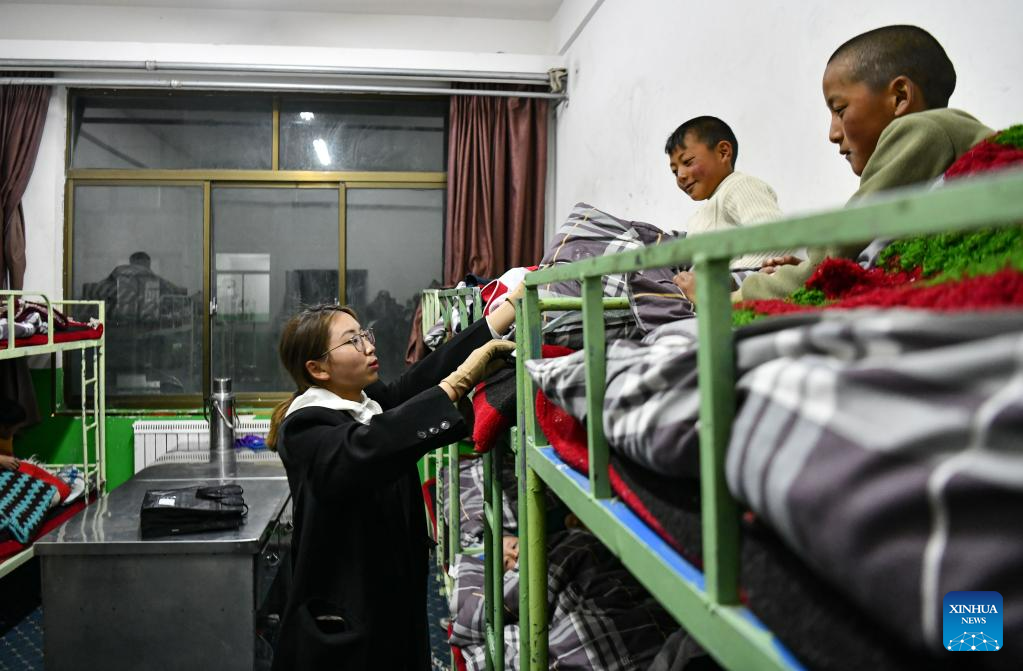
A teacher takes care of the pupils at the dormitory of a primary school of Zhaxizom Township in Tingri County, Xigaze City, southwest China's Tibet Autonomous Region, June 5, 2023.
The primary school of Zhaxizom Township is the closest school to Mount Qomolangma, with a distance of just over 40 kilometers. To meet the various needs of the students, the school has established interest classes such as piano, information technology, art, broadcasting, sports, dance, and handicrafts.
Currently, the primary school has only one piano. Therefore, electronic keyboards are used as substitutes sometimes. Even so, it still leaves the piano teacher, Basang, feeling deeply moved.
As a local resident of Tingri County, Basang came to the school three years ago after graduating from a normal university where she learned to play the piano. "When I was in primary school, we didn't have a piano, let alone piano lessons," Basang said, "What a complete change!"
The primary school was established in 1983 and underwent a renovation and expansion project with a national investment of 8 million yuan (about 1.12 million U.S. dollars) in 2010. In 2016, the government invested over 40 million yuan (about 5.6 million U.S. dollars) for further expansion, resulting in the current scale of the school.
Today, the school has 20 classes across 6 grades, with a total of 921 students. It is equipped with modern teaching facilities, and through the national smart education platform for primary and secondary schools, students here are able to enjoy teaching resources of first-tier cities. Specialized science laboratories, calligraphy classrooms, computer rooms, libraries, and art rooms are all well-equipped. Additionally, there is an artificial turf football field and an indoor gym.
In addtion to the comprehensive facilities, children of farmers, herders and urban families facing difficulties are also exempted from meal, lodging and basic school expenses thanks to the free education policy implemented by the government in 1985.
As of 2021, the policy has benefited nearly 9 million students in Tibet, with the government investing over 20 billion yuan (about 2.8 billion U.S. dollars) in total. Currently, Tibet has also expanded this policy to preschool education. (Xinhua/Jigme Dorje)
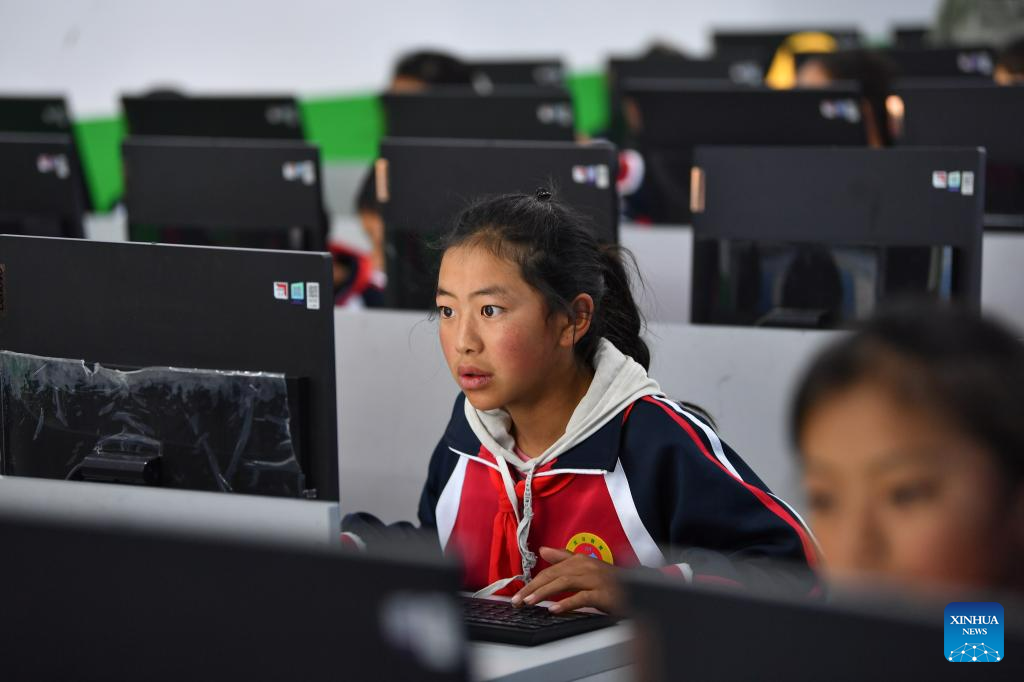
Pupils attend a computer class at a primary school of Zhaxizom Township in Tingri County, Xigaze City, southwest China's Tibet Autonomous Region, June 5, 2023.
The primary school of Zhaxizom Township is the closest school to Mount Qomolangma, with a distance of just over 40 kilometers. To meet the various needs of the students, the school has established interest classes such as piano, information technology, art, broadcasting, sports, dance, and handicrafts.
Currently, the primary school has only one piano. Therefore, electronic keyboards are used as substitutes sometimes. Even so, it still leaves the piano teacher, Basang, feeling deeply moved.
As a local resident of Tingri County, Basang came to the school three years ago after graduating from a normal university where she learned to play the piano. "When I was in primary school, we didn't have a piano, let alone piano lessons," Basang said, "What a complete change!"
The primary school was established in 1983 and underwent a renovation and expansion project with a national investment of 8 million yuan (about 1.12 million U.S. dollars) in 2010. In 2016, the government invested over 40 million yuan (about 5.6 million U.S. dollars) for further expansion, resulting in the current scale of the school.
Today, the school has 20 classes across 6 grades, with a total of 921 students. It is equipped with modern teaching facilities, and through the national smart education platform for primary and secondary schools, students here are able to enjoy teaching resources of first-tier cities. Specialized science laboratories, calligraphy classrooms, computer rooms, libraries, and art rooms are all well-equipped. Additionally, there is an artificial turf football field and an indoor gym.
In addtion to the comprehensive facilities, children of farmers, herders and urban families facing difficulties are also exempted from meal, lodging and basic school expenses thanks to the free education policy implemented by the government in 1985.
As of 2021, the policy has benefited nearly 9 million students in Tibet, with the government investing over 20 billion yuan (about 2.8 billion U.S. dollars) in total. Currently, Tibet has also expanded this policy to preschool education. (Xinhua/Jigme Dorje)
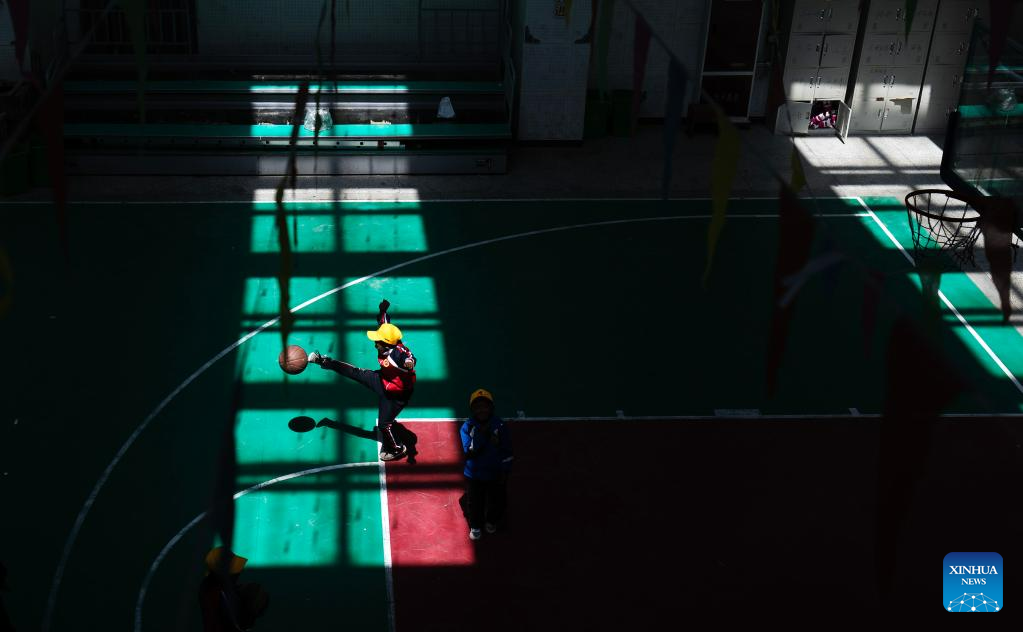
Pupils attend a basketball class at the indoor gym at a primary school of Zhaxizom Township in Tingri County, Xigaze City, southwest China's Tibet Autonomous Region, June 5, 2023.
The primary school of Zhaxizom Township is the closest school to Mount Qomolangma, with a distance of just over 40 kilometers. To meet the various needs of the students, the school has established interest classes such as piano, information technology, art, broadcasting, sports, dance, and handicrafts.
Currently, the primary school has only one piano. Therefore, electronic keyboards are used as substitutes sometimes. Even so, it still leaves the piano teacher, Basang, feeling deeply moved.
As a local resident of Tingri County, Basang came to the school three years ago after graduating from a normal university where she learned to play the piano. "When I was in primary school, we didn't have a piano, let alone piano lessons," Basang said, "What a complete change!"
The primary school was established in 1983 and underwent a renovation and expansion project with a national investment of 8 million yuan (about 1.12 million U.S. dollars) in 2010. In 2016, the government invested over 40 million yuan (about 5.6 million U.S. dollars) for further expansion, resulting in the current scale of the school.
Today, the school has 20 classes across 6 grades, with a total of 921 students. It is equipped with modern teaching facilities, and through the national smart education platform for primary and secondary schools, students here are able to enjoy teaching resources of first-tier cities. Specialized science laboratories, calligraphy classrooms, computer rooms, libraries, and art rooms are all well-equipped. Additionally, there is an artificial turf football field and an indoor gym.
In addtion to the comprehensive facilities, children of farmers, herders and urban families facing difficulties are also exempted from meal, lodging and basic school expenses thanks to the free education policy implemented by the government in 1985.
As of 2021, the policy has benefited nearly 9 million students in Tibet, with the government investing over 20 billion yuan (about 2.8 billion U.S. dollars) in total. Currently, Tibet has also expanded this policy to preschool education. (Xinhua/Fei Maohua)



